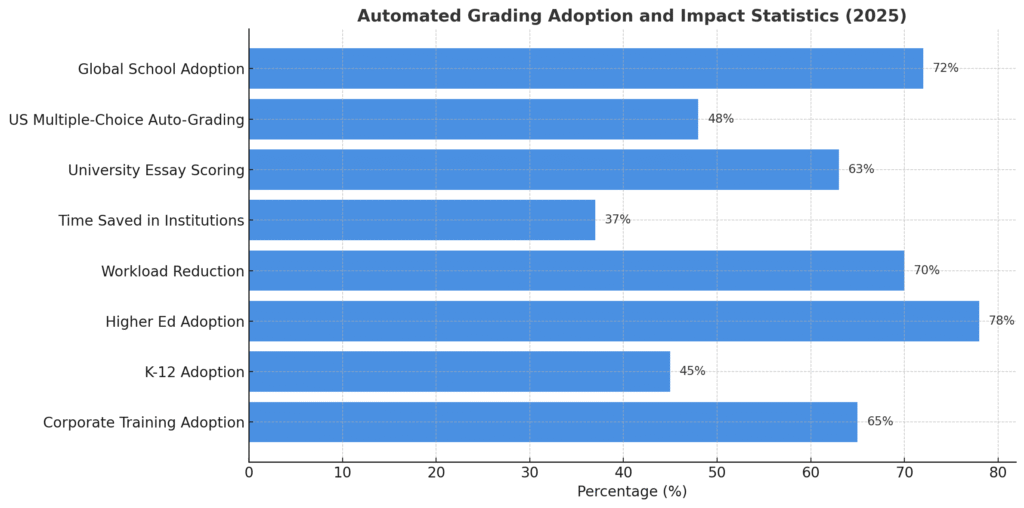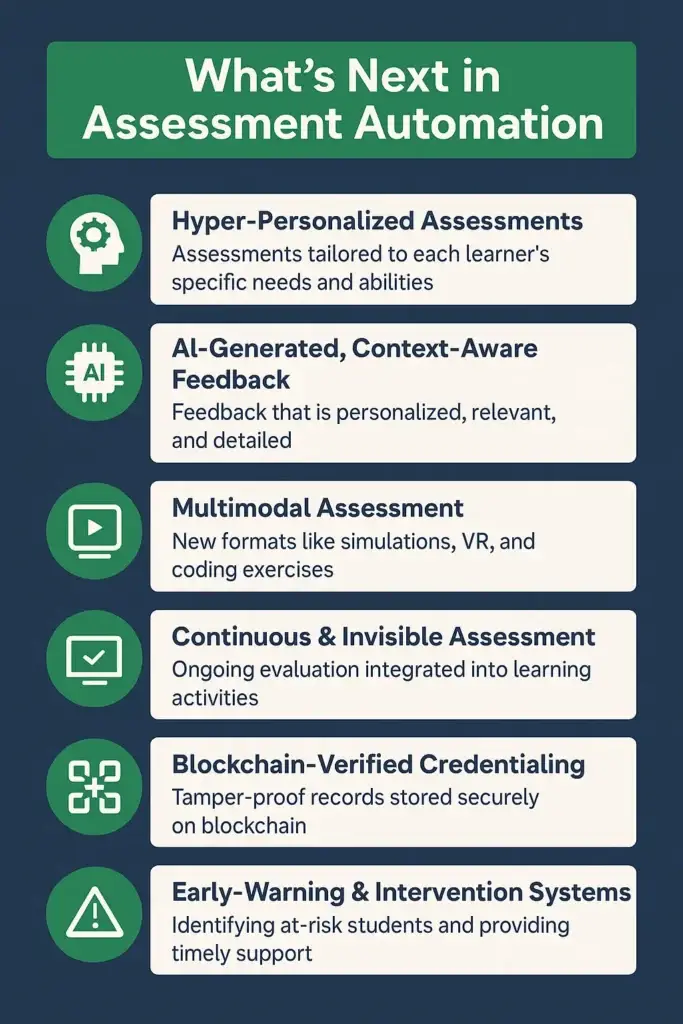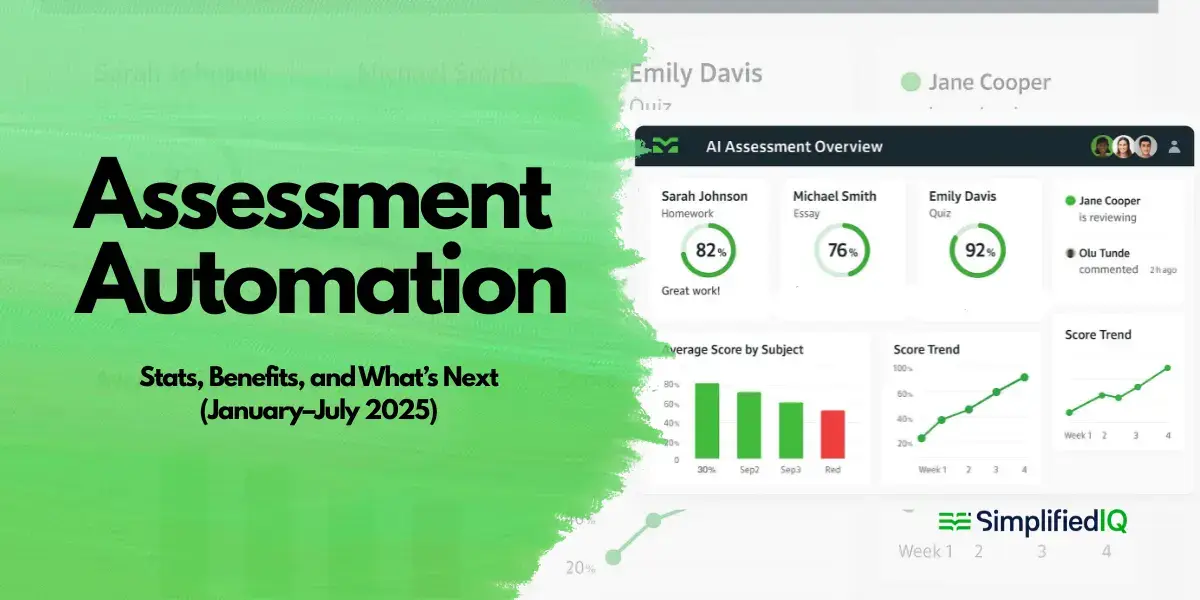In the first half of 2025, assessment automation tools have moved from being a helpful add on to an essential part of education, hiring, and corporate training. With growing pressure to save time, stay fair, and scale assessments across large groups, more schools, universities, and workplaces are turning to automation.
Computer-based testing (CBT), online proctoring and AI driven tools that make grading, testing, and evaluating faster are now being prioritized in schools, during recruitment, and for certifications purposes.
In this post, we’ll break down the latest statistics (January – July 2025), examine how automation is taking over traditional methods (adoption), highlight its key benefits, and take a look at what’s coming next.
What Is Assessment Automation?
Perhaps you are seeing the term “Assessment automation” for the first time. This refers to the use of technology, often powered by AI and machine learning, to streamline or completely automate various stages of the assessment process, including:
- Test creation
- Distribution
- Proctoring
- Grading
- Feedback generation
- Data analysis and reporting
Are you one of those who have asked, “how has automation improved how assessment is done?” We’ll highlight a few ways assessment automation has has helped in these sectors.
In Education:
- Auto-graded quizzes and exams save time and offer immediate results.
- Adaptive testing algorithms adjust question difficulty in real time, creating personalized, accurate, and engaging assessments for each student.
- Remote proctoring tools use facial recognition and behavior tracking for exam integrity.
In Recruitment:
- Skill-based automated tests are now common in tech, finance, and customer service roles.
- Natural Language Processing (NLP) is used to assess written responses for tone, clarity, and relevance.
- Video interviews analyzed by AI identify communication strengths and weaknesses.
Benefits of Assessment Automation
For Educators:
- Less time spent on grading = more time for teaching and mentoring
- Better insights into student progress through real-time data
- Reduced grading bias
For Recruiters:
- Faster screening of candidates
- Improved accuracy in shortlisting
- Scalable hiring processes across multiple roles
For Students & Candidates:
- Faster feedback loops
- Improved transparency in scoring
- Opportunities to learn from mistakes immediately
Key Statistics on Assessment Automation in (January–July 2025)
Before we get to the statistical details, here is a quick overview of some outstanding statistics in the US.

Assessment Automation in Education
- Universities aren’t just tolerating AI, they’re embracing it.
- 48% of multiple-choice assessments are auto-graded in public schools.
- 63% of universities now use AI to score essays, though many still include human oversight for balance (SQ Magazine, 2025).
- AI powered tools are cutting workload significantly with up to a 70% reduction in grading time, particularly in large-volume settings like MOOCs and first-year university courses (KhrisDigital, 2025).
- Instead of waiting weeks, students now receive personalized feedback within hours.
- 78% of higher education institutions now use auto-grading for at least some assignments.
- 45% of K-12 schools have adopted AI-assisted grading.
Assessment Automation in the Workplace
- Over 65% of corporate training programs are now using automated tests and analytics to personalize learning and track performance improvement (WhatsTheBigData, 2025. Corporate Training Gets Smarter with AI).
- Employers are turning to automated psychometric tests to dig deeper. assessing how candidates think, behave, and solve problems.
LLMs Are Grading Too, and Doing It Well
Large Language Models (LLMs) like GPT have made their way into classrooms, too. A January 2025 study showed that GPT-style tools graded short-answer questions in a bioinformatics course just as accurately as human teaching assistants, with students reporting similar satisfaction with the feedback they received.
Assessment Automation Impact Statistics
In Adoption
AI and ML Driving Smarter Assessments
Between 2023 and 2025, AI adoption in assessment systems has more than doubled (from 7% in 2023 to 16% in 2025), reflecting a growing reliance on machine learning for tasks like auto-grading, adaptive testing, and predictive performance analytics. Modern platforms use these capabilities to not only mark answers but also provide instant, personalized feedback, helping educators and organizations streamline the entire assessment cycle.
Market Momentum and Investment
The global assessment automation market is on track to reach record highs ($52.7 billion by 2027), fueled by U.S. edtech and corporate training providers investing heavily in computer-based testing (CBT), AI-powered grading, and remote proctoring solutions. This surge highlights the demand for scalable, consistent, and data-driven evaluation methods in both education and workforce training. (Global Newswire)
Moving Away from Manual Grading
Manual processes are rapidly fading in both testing and grading. Only a small fraction (14% ) of teams reporting no change in manual processes. This shift toward automation-first strategies reflects the growing role of assessment automation in reducing repetitive tasks, accelerating feedback, and enabling educators to focus more on teaching and mentorship rather than paperwork.
In Learning Outcomes
Faster Feedback Boosts Learning
With assessment automation, students receive instant, data-driven feedback that highlights mistakes in real time. This allows them to address misconceptions while the material is still fresh in their minds. Research from large-scale online learning programs shows that timely feedback can boost engagement and retention by 20–30%, making it easier for learners to master concepts efficiently.
Higher Course Completion Rates
In digital and blended learning environments, automated assessments create faster feedback loops that keep learners motivated. Studies have found that students who receive regular, automated feedback are significantly more likely to submit assignments on time and complete courses, reducing dropout rates in both online and traditional settings.
Personalized Learning for Better Performance
Modern assessment automation tools often integrate adaptive testing, adjusting question difficulty to match each learner’s ability. This personalized approach not only keeps students challenged at the right level but has also been shown to improve scores by 10–15% compared to fixed-format tests. As a result, educators can better target support while students benefit from a more customized learning experience.
In Various Countries
Singapore is on a mission to become a global leader in AI by 2030, and education is a big part of that plan. Through its Smart Nation vision, the country is bringing together experts, educators, and tech innovators to make learning more personalized and inclusive. One major focus is assessment automation, using AI to grade assignments, give tailored feedback, and track each student’s progress in real time. These tools are especially valuable for students with special needs, helping teachers adapt lessons and activities to suit different learning styles. By combining automated grading with machine learning, Singapore is aiming to make classrooms more responsive, engaging, and effective for every learner
In the United States, assessment automation is becoming mainstream, with a 2024 nationwide survey revealing that 60% of educators now use AI-powered tools for grading, feedback, and student performance tracking. These systems are saving teachers an average of six hours per week, freeing up time for lesson planning and student support. Globally, 72% of schools have adopted AI grading solutions, and U.S. districts are leading the charge in piloting predictive analytics that identify learning gaps before they impact final grades.
South Korea is transforming its education system with AI-powered assessment automation that tailors homework and assignments to each student’s academic level, learning style, and behavior. Every child will have access to a personalized AI tutor and a national online learning platform. According to the country’s education minister, this shift is designed to move public schools beyond a memorization-heavy model, bringing them closer to the personalized and in-depth learning typically found in elite private institutions.
Canada is embracing AI in education to deliver personalized learning experiences. One 2024 study reported that 68% of secondary schools using AI tools experienced improved student engagement and academic outcomes. While still emerging, assessment automation is being piloted in select districts, with educators exploring its impact on customized feedback and performance tracking.
China has rolled out one of the most ambitious AI-in-education programs, with 90% of its provinces implementing policies to integrate AI into classrooms. Over 500 “AI-model schools” now use smart grading, adaptive learning platforms, and real-time performance analytics. In some schools, students already spend more than eight hours a week working with AI-assisted learning tools, a shift that the Ministry of Education says is essential for scaling personalized learning across the country’s massive student population.
Impact on Grades
Writing Improvement
At the University of Michigan, integrating automated writing assessments alongside peer review led to a 23% improvement in writing scores compared to control groups following traditional grading practices. (numberanalytics)
Math Success at Scale
Arizona State University implemented adaptive assessment systems in freshman math courses. As a result, course failure rates dropped by 45% while progression to higher-level courses rose by 27%
Lower Failure, Higher Retention
Adaptive grading contributed to a 27% increase in student retention, supported by real-time analytics and personalized feedback Number Analytics.
Enhanced Student Focus
Research from the Journal of Asian Development Studies showed that automated grading systems cut teacher grading time by 35% (from 15 to 9.75 hours weekly), while student assignment submission rose from 70% to 88% and classroom participation jumped from 65% to 81% poverty.com.pk.
What’s Next in Assessment Automation?

1. Adaptive & Personalized Assessments
AI isn’t just grading, it’s adapting. Systems are increasingly tailoring not only question difficulty, but also formats and pacing to match a student’s performance and learning needs. These intelligent platforms create customized learning paths that adjust in real time. Wikipedia
2. Rich Feedback & Emotion-Aware Learning
Advanced AI tools are moving beyond basic automated grading. Future systems can offer context-aware feedback and evaluate students’ emotional or cognitive engagement with the material, providing more meaningful, supportive responses. Number Analytics
3. Multimodal & Continuous Assessment
Assessments are evolving to include audio, video, simulations, and interactive media, not just quizzes. At the same time, evaluation is becoming part of the learning journey, seamlessly woven into lessons rather than confined to scheduled tests. Wikipedia
4. Secure Digital Credentials & Blockchain
Imagine sharing your grades and personal information via verifiable, tamper-proof digital badges, blockchain makes that real. Talview Blog
5. Early Warning Systems with Data Analytics
AI is becoming proactive, helping educators spot students at risk earlier and intervening swiftly. These platforms like SimplifiedIQ use data to guide instructional responses and improve learner outcomes. Wikipedia
Conclusion
From January to July 2025, adoption of assessment automation has skyrocketed with AI, cloud-based platforms, and growing market demand. The result? Knowledge assessment that’s faster, fairer, and more cost-effective, transforming everything from university grading to corporate hiring assessments.
Assessment automation isn’t the future, it’s happening now. SimplifiedIQ is already leading the way with personalized testing, instant, meaningful feedback, and early alerts (from data) for struggling students. And we’re not stopping, we’re building next-gen multimodal assessments and secure blockchain credentials to keep education smarter, faster, fairer, and your personal information safer.
Want to see how it works? Book your free demo slot here
- SimplifiedIQ Wins CEOs Network Africa Award for Technology and Innovation
- Top SMEs in Nigeria: SimplifiedIQ Recognized by BusinessDay
- Assessment Automation: Benefits, Stats, and What’s Next (January–July 2025)
- Online Proctoring Solutions for Secure Tests and Assessments
- Step-by-Step Guide to Setting Up Online Proctoring for Secure Exams




